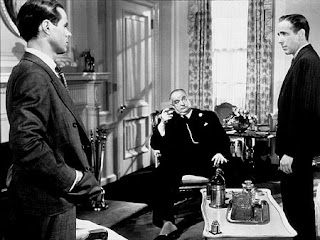

Wilmer Cook (Elisha Cook) , Mr. Gutman (Sydney Greenstreet) and Sam Spade (Humphrey Bogart).
In the original novel "The Maltese Falcon" of Dashiell Hammett, detective Sam Spade was a sort of reflection of Hammett' own experiences as a private investigator for Pinkerton Detective Agency in San Francisco. The character wasn't only invested with characteristics from the autor's personality but also was given his first name, Samuel.
This novel had inspired two more versions before the one from 1941. The first " Maltese Falcon" was released ten years earlier with the actor Ricardo Cortez playing detective Sam Spade. The second version was called "Satan met a lady" and it was an adaptation that turned the original mystery story into a light comedy and with the characters renamed. It was releasedin 1936 with a young Bette Davis and Warren William in the main roles.
Warner Brothers had problems and were warned by the Hays Code censors about the re-realising of the 1931 film for its content being considered "lewd" or, in other words, obcene. This fact was probably taken into account at the moment of producing the new, cleaned-up version (it was just in 1966 when unedited copies of the 1931 film could be shown in USA. But the new film wasn't free of controversy yet since the censors still considered that it had certain homosexual implication, specifically in Elisha Cook' character, Wilmer Cook, who was Mr. Gutman's loyal servant and thug. In fact is Hammett himself who describes the young Wilmer as a "catamite" (a young man involved in a sexual relationship with an older man) and because this term was objected and rejected by the publisher of the novel, Hammett was obliged to change "catamite" into "gunsel", a street slang with the same meaning. Very few people were familiar to this word and most of the readers understood that it refered to a "gun man", which was linked to the character.
This novel had inspired two more versions before the one from 1941. The first " Maltese Falcon" was released ten years earlier with the actor Ricardo Cortez playing detective Sam Spade. The second version was called "Satan met a lady" and it was an adaptation that turned the original mystery story into a light comedy and with the characters renamed. It was releasedin 1936 with a young Bette Davis and Warren William in the main roles.
Warner Brothers had problems and were warned by the Hays Code censors about the re-realising of the 1931 film for its content being considered "lewd" or, in other words, obcene. This fact was probably taken into account at the moment of producing the new, cleaned-up version (it was just in 1966 when unedited copies of the 1931 film could be shown in USA. But the new film wasn't free of controversy yet since the censors still considered that it had certain homosexual implication, specifically in Elisha Cook' character, Wilmer Cook, who was Mr. Gutman's loyal servant and thug. In fact is Hammett himself who describes the young Wilmer as a "catamite" (a young man involved in a sexual relationship with an older man) and because this term was objected and rejected by the publisher of the novel, Hammett was obliged to change "catamite" into "gunsel", a street slang with the same meaning. Very few people were familiar to this word and most of the readers understood that it refered to a "gun man", which was linked to the character.
History
In July, 1941 the U.S. had not enter WWII yet. The climate in those years was thick, because of the possible role that the United States of America would play on the second world war. Although the U.S. tried to stay out of the butchery that WWII became, it was impossible to remain peaceful when in December, 1941, the Pacific side was attacked by Japanese bombers, destroying the American's military base: Pearl Harbour.
The movie was released in 1941, but the novel in which the movie is based on, was published in the 1930s. This was dangerously closed to 1929, the time when the stock market had a dramatic drop causing a Great Depression that affected the whole of the world's economy. Entertainment looked like the best way to escape from the cruel reality that the unemployment rates and the lack of food brought about. The gangster were also filling the streets and maybe detective and murder stories got their ideas from them. Headlines of that time were filled with the deaths the gangs left and the blood they spread in the search of revenge.
There is a lot to look at when analizing a film. It is important to know what important events surrounded the release year, or in this case the year when the novel was published. Furthermore, a movie can be better understood having the right perspective and the background that precedes a film.


1 comentario:
Hey guys!
I visited your web page and I found it very interesting, I think having a subject about films is innovative, we don't have subjects like that in my university, now you have the opportunity to learn more about it and also people who visit your blog (I didn't know what a film noir was :S).
I haven't seen the movie yet, but I will very soon, I read all the information you have here and I think this is a movie that is worth to be seen.
Publicar un comentario